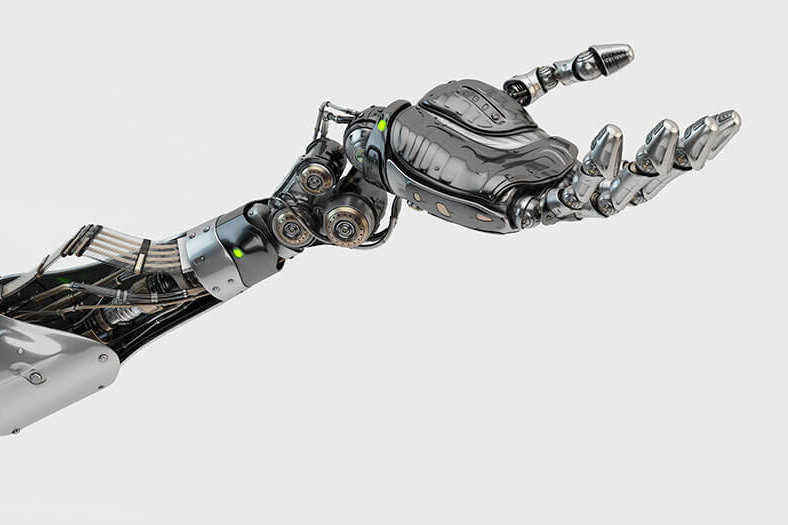
@Vladislav Ociacia/stock.adobe.com
Tesla unveiled their plan to create a humanoid robot at its AI day conference. It will be able to help around the house with tasks, get groceries, and . . . well, it’s hard to say how useful it would actually be, but it looks sleek (and existentially frightening if we think about the plot of most sci-movies on the subject).
It’s built around the same AI technology as Tesla’s self-driving cars. They claim a prototype will be available “sometime next year,” though the technology still faces immense hurdles and will probably take longer.
A company called Boston Dynamics already builds humanoid robots that continue to improve over time. In one video, they show off their prototype robots by having them do preprogrammed parkour. Their incredible routine ends with a backflip.
At present, Boston Dynamics already mass manufactures robots on four legs, affectionately called “Spot.” The owner can automate Spot to accomplish tasks on its own or control it themselves. Companies in mining, oil and gas, construction, utilities, and even NASA use these robots to perform all kinds of tasks, often ones that are dangerous for humans.
If all of that sounds terrifying, don’t worry: they’ve made sure that “humans can outrun them.”
Isn’t that encouraging?
Some more positive areas of futuristic development include:
- A cranial surgery was successfully performed on an epileptic child in 2019 with the help of a robot.
- Some robots being developed are nearly microscopic and help eliminate cancer cells.
- In New Zealand, a company is testing drone deliveries for things like pizza.
- Self-driving cars and humanoid delivery robots continue to be developed.
It seems like technology is catching up to The Jetsons.
Will humanity be “terminated”?
The takeover of Schwarzenegger-like Terminator robots is probably not going to happen, but the movie’s AI network known as Skynet may pose a greater danger. To understand why, we need to clarify some terms. Three kinds of technology can get easily confused:
- Robots: Robots simply do repeatable tasks. These have been used for years to make factory assembly lines more efficient and sometimes entirely automated. They can also be dancing toys for kids.
- Specific or Narrow AI: This is a program that learns and adapts. These kinds of AI can already beat humans in some of the most complex games. An AI defeated the human champion of the notoriously complex Chinese game Go. Such AI is used in self-driving cars, and, more vitally, in social media and Google. One will also find the term “deep learning,” which refers to the depth of layering in the AI’s program. Sometimes people will use the term “algorithm” to avoid confusion with artificial general intelligence.
- Artificial general intelligence (AGI): No one has developed an AGI (at least, not publicly). AGI would perform a wide range of cognitive tasks at the same level or better than humans. AGI could learn, like a child, how to play multiple kinds of games and navigate different problems fluidly. This could conceivably mean that the AGI would experience creativity and even emotions.
Though AGI is what most people think of when they hear the acronym AI, companies that use AI are utilizing narrow AI. AGI raises philosophical questions: Would it be self-aware? Would it have a mind? Would it be “alive?” Though interesting, we’ll put off those inquiries for another time.
Physicist and machine learning expert Max Tegmark argues that humanity will probably not be overtaken by robots. If an AGI were set on gaining power, it wouldn’t need robots. It could just influence people through their phones, control computers, and leverage the economy. That concept is a bit more frightening than skull robots with machine guns if you ask me.
That said, Tegmark is optimistic about the positives of AGI if we control it well. Some experts doubt whether AGI will ever exist, though surprisingly most think it will be invented in the next century.
The far more prevalent issue of today is companies’ usage of narrow AI.
How TikTok employs machine learning to keep you watching
The key component of AI is “machine learning,” which makes predictions based on large amounts of data. Give it data about how long one hundred million people spent watching a cat on YouTube and it will interpret that data to know who else might like to watch that video.
The site that probably utilizes this most efficiently is TikTok. In TikTok, people refer to the narrow AI as the algorithm. The ubiquitous algorithm learns the user’s preferences over time so that the content changes to exactly fit each person. Their feed will become dominated by what they spend the most time watching, whether it’s cooking, political, informational, DIY, funny, or even ironic videos making fun of TikTok itself. The variety of TikTok content is astounding; it has something for everyone.
Endless swiping and millions of creators provide nearly limitless content, and what’s presented is actively personalized by a massive AI network. It’s no wonder that TikTok users spend an average of one hour per day on the app and that 90 percent of TikTok users view it daily.
This strategy leads to some predictable downfalls.
If someone watches conspiracy videos from certain creators, the AI will begin showing the user what they want to see—probably more conspiracy videos. Just like in other social media sites, this can lead to inbred thinking. On TikTok, though, the effective AI makes it particularly compounded.
Additionally, though TikTok technically regulates pornography, the content is nonetheless often heavily sexualized, and loopholes to pornography exist, especially for users who want to see it. Many users won’t see any sexual content on TikTok, but that’s because each individual’s feed is personalized to them.
TikTok’s explosive growth demonstrates the power of AI.
AI is everywhere
Though TikTok is a prevalent example, narrow AI’s influence is not limited to that demographic. Essentially every major media site now uses targeted advertisements with the help of AI.
- Amazon predicts what purchases their shoppers will want, personalizing the home page to incentivize buying.
- Netflix predicts what shows will keep its users on their site. The AI can also choose a still shot from a movie to show as the cover seen on the homepage and changes it to renew interest in its users. This is why Netflix’s homepage appears differently for different people.
- Gmail and Google Docs will often predict the next word a writer will type (and is, in fact, doing so as I write this article).
- Facebook identifies people’s faces and interprets the content of posts to target advertisements based on conversations.
- Google uses AI for translation. The AI learns and improves over time so that Google Translate will improve year over year.
- YouTube uses AI to flag videos, recommend the next videos, and, again, target ads.
- Spotify uses machine learning to customize each listener’s experience.
The list goes on. I recommend this article for a helpful summary.
Remember, each of these AIs are narrow and specifically designed for each task. Each company is not using one universal AI and applying it to their goals. That would require AGI.
Nonetheless, AI is a powerful tool. In certain applications, AI, just like robots, efficiently solves problems and works for everyone’s benefit. At the same time, tools in the hands of sinful people will lead to abuse.
AI does whatever it is designed to do very, very well. If AI is designed to keep people watching TikTok and YouTube, it will do that. Predictably, the better machine learning has become, the better it keeps people on their phones. The negative effects of high screen times have been written about widely.
Does the Bible speak to this modern invention?
What does the Bible say about AI?
The biblical implications of AGI, a conscious artificial mind, would take far longer to cover (though it may become necessary at some point). For now, we’ll just cover narrow AI and two dangers Christians should be aware of.
AI magnifies temptation
Since AI has the unique ability to magnify what users want, it, therefore, magnifies fleshly desires. Certainly, this is true of sexual temptations. It is also true of countless other sins: jealousy, self-indulgence, etc. AI will follow whatever vice it gets a hold of. It knows to sell alcohol to alcoholics; it knows to peddle sin to sinners.
The Bible says to flee sexual immorality and the desires of the flesh (1 Corinthians 6:18; Romans 8:5). If certain platforms cause temptation, throw them away or limit them. Know that Satan can use algorithms to magnify temptations.
Someone I know became addicted to buying unnecessary things from Amazon and had to impose restrictions on his own bank account.
If the hand causes sin, cut it off (Matthew 5:30).
AI magnifies time-wasting
Fasting reminds us of God’s provision and leads to thankfulness. Fasting from social media can create the practical effect of detaching us from the grip of its influence.
This past week, I spent a ludicrous amount of time on YouTube, and so decided to take a break from it for at least a week. In the past year, my mother completely deleted her Facebook account due to having wasted too much time on the site.
Paul writes, “Look carefully then how you walk, not as unwise but as wise, making the best use of the time, because the days are evil. Therefore do not be foolish, but understand what the will of the Lord is” (Ephesians 5:15–17).
Don’t let this become legalism or judgmentalism, and certainly do not fast so that others will see you—social media isn’t evil. Nonetheless, we must be wise with our screen time and remember that algorithms are actively trying to keep us online.
It’s clear that AI is used for good in many of its applications. As Christians, however, we must be aware of its grip and know that Satan can use it against us. Let us be “crafty as serpents and innocent as doves” and honestly know ourselves and our own sin (Matthew 10:16; Lamentations 3:40).
Before we turn our eyes to screens, let us turn our eyes to Christ.












